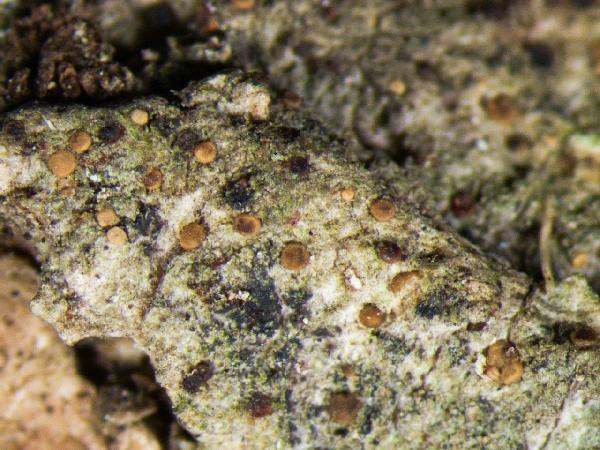Bacidina assulata (Körb.) S. Ekman
Opera Bot., 127: 116, 1996. Basionym: Bacidia rubella var. assulata Körb. - Parerga Lichenol.: 131, 1860.
Synonyms: Bacidia anomala A. Massal.; Bacidia assulata (Körb.) Vězda; Bacidia effusa auct.; Bacidina delicata auct. p.p. non (Leight.) V. Wirth & Vězda; Bacidina mendax Czarnota & Guzow-Krzem.
Description: Thallus crustose, episubstratic, continuous to granulose, whitish or greenish grey, partially dissolved into loosely aggregated, 16-29 μm wide goniocysts in small patches. Apothecia biatorine, 0.3-0.6 mm across, pink, brown-orange or purple-brown, often mottled, with a flat, epruinose disc and a concolorous, distinct proper margin. Proper exciple laterally c. 60 μm wide, without crystals, of rather thin (2-3 μm), radiating hyphae, orange-brown in the outer rim, colourless within; epithecium orange-brown, scarcely differentiated from the hymenium; hymenium colourless in lower part, orange-brown in upper part, 60-75 μm high; paraphyses c. 1.2 μm thick at mid-level, the apical cells 2.5-3.5 μm wide, without internal pigment; hypothecium colourless or very pale yellow; all pigmented parts of apothecia K+ intensifying, N-. Asci 8-spored, clavate to cylindrical-clavate, the apical dome K/I+ dark blue with a pale, conical-pointed apical cushion (axial mass) never penetrating through the entire d-layer, the wall K/I-, but the thin outer gel K/I+ blue, Bacidia-type. Ascospores 5-9-septate, needle-like, straight or curved, 34-45(-54) x 1.5-2.5 μm. Pycnidia immersed, colourless. Conidia 1-celled, thread-like, strongly curved, 10-43 x (0.5-)0.8-1 μm. Photobiont chlorococcoid, the cells 5-12 μm in diam. Spot tests: thallus and apothecia K-, C-, KC-, P-, UV-. Chemistry: thallus without lichen substances; apothecia with the Rubella-orange pigment.
Growth form: Crustose
Substrata: bark
Photobiont: green algae other than Trentepohlia
Reproductive strategy: mainly sexual
Commonnes-rarity: (info)
Alpine belt: absent
Subalpine belt: absent
Montane belt: absent
Dry submediterranean belt: very rare
Humid submediterranean belt: very rare
Padanian area: absent
pH of the substrata:
1 2 3 4 5
Solar irradiation:
1 2 3 4 5
Aridity:
1 2 3 4 5
Eutrophication:
1 2 3 4 5
Poleotolerance:
0 1 2 3
Altitudinal distribution:
1 2 3 4 5 6
Rarity
absent
extremely rare
very rare
rare
rather rare
rather common
common
very common
extremely common
Loading data...
Occurrence data
Predictive map
Growth form: Crustose
Substrata: bark
Photobiont: green algae other than Trentepohlia
Reproductive strategy: mainly sexual
Commonnes-rarity: (info)
Alpine belt: absent
Subalpine belt: absent
Montane belt: absent
Dry submediterranean belt: very rare
Humid submediterranean belt: very rare
Padanian area: absent
pH of the substrata:
| 1 | 2 | 3 | 4 | 5 |
Solar irradiation:
| 1 | 2 | 3 | 4 | 5 |
Aridity:
| 1 | 2 | 3 | 4 | 5 |
Eutrophication:
| 1 | 2 | 3 | 4 | 5 |
Poleotolerance:
| 0 | 1 | 2 | 3 |
Altitudinal distribution:
| 1 | 2 | 3 | 4 | 5 | 6 |
Rarity
absent
extremely rare
very rare
rare
rather rare
rather common
common
very common
extremely common
Loading data...
Occurrence data
Predictive map







